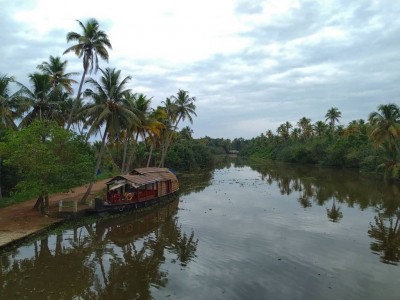
Kerala, the glorious "Gods own country" is blessed with greeneries, water lagoons and marine ecosystem comprising a land area of 38,863 km2 merely 1.18 per cent of Indias landmass is placed between the Lakshadweep Sea to the west and forest-grown mountain range, the Western Ghats in the east.
The state has varying three climatically distinct regions with a coastal belt of 560km. In the eastern part, we have highlands with mountain terrain ornamented with tropical rain forest, central rolling hills, and western hot and wet lowland containing a diversity of freshwater, brackish water, and marine ecosystems that constitute the coastal plain.
Climatic conditions of Kerala are influenced by seasonal showers of rain brought in by the much-blessed monsoon.
The biodiversity and ecosystem of Kerala are performing fine services to mankind in several ways directly and also indirectly. Such ecosystem service includes water purification, control of soil erosion, flood control, agriculture pollination, carbon storage, and climate regulation, and also the generation of oxygen by greeneries through photosynthesis.
The Western Ghats perform very important hydrological and watershed functions.
250 million people depend on the Western Ghats for drinking water in peninsular India and in Kerala, the origin and source of water for our rivers are from these Ghats.
The unprecedented and alarming rate of degradation is progressing towards our precious environment and biodiversity today. The unsustainable harvest of natural resources, soil erosion, land-use change, and soil quality deterioration, sea-level rise in the low lying areas, forest degradation, loss of biodiversity, water tables are falling, pollution and waste accumulation, change of virulence, and disease pattern especially waterborne and vector-borne diseases.
New infectious disease has been discovered each year due to climate change-related paradigms over the past several decades; several diseases are drug resistance, the reappearance of old diseases such as diphtheria, cholera, dengue fever, yellow fever, etc.
The environmental viability of our life support is degrading, climatic change is at its threatening peak and the gap among the rich and poor is widening dangerously, even threatening the system are the major issues to be addressed in the coming year.
Ecosystems like wetlands, forests, mountain terrains, and green covers are depleting alarmingly in Kerala is a potent threat to address climate change. If the current environmental trends of Kerala are unsustainably managed especially in resource depletion, climate change instigated torrential rain, drought, flood, landslides, global pandemic outbreak; the disease can predict an unstable situation with a series of catastrophic implications.
Speedy and more strategy-oriented remedial measures need to be necessary to address these imminent challenges otherwise a negative scenario is more likely.
Recurrent floods through torrential rain and subsequent landslides in recent years and followed by unprecedented droughts have demanded Kerala for a nature-based solution that involves working with nature to better conserve, manage, protect or restore the much demanding and critical or fragile ecosystems.
A nature-based solution comprises a wide range of ecosystems on terrestrial, aquatic, and marine habitats and should be designed and implemented in partnership with local communities and stakeholders in a decentralised fashion. Resilience in design to provide measurable benefits to biodiversity is the key factor of a nature-based solution. The inflow of financial and technical expertise from national and global dimensions is the key source of its success. Kerala needs a global, multifaceted, long-term environmental strategy and goals to make a better and brighter future.
Research and development of new technologies to mitigate climate change, such as carbon capture and reuse, aquaponics, hydroponics, vertical urban agricultural installations in high rise buildings, saltwater agriculture, pure meat without growing animals, electric cars, advanced solar power grabbing systems, maglev trains, urban biodiversity conservation, up gradation of green cover and reforestation, use of renewable energy sources and technology enhanced mitigations are best fitting.
Our development vision must have conservation oriented design for environment, biodiversity, landscapes, critical ecosystems and hotspots coupled with decentralised governance and inescapable people's participation. Development of Kerala must have a policy best utilising the available world class science and technology trends to keep in mind the essential needs of present and future generation.


.jpeg)

